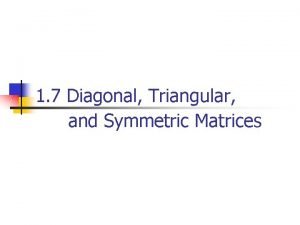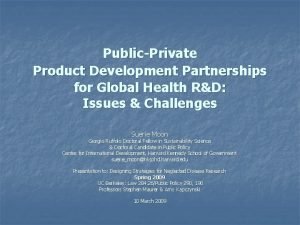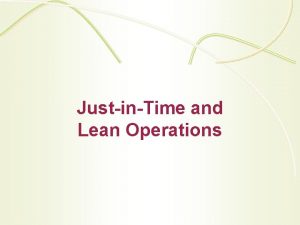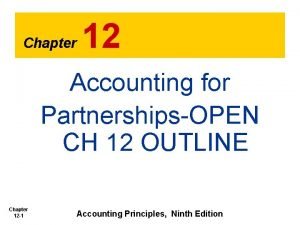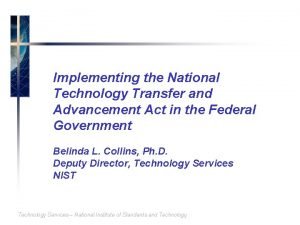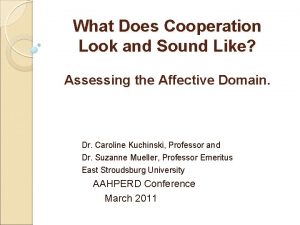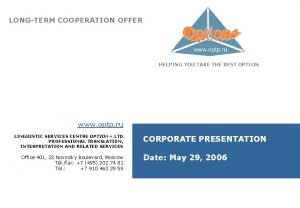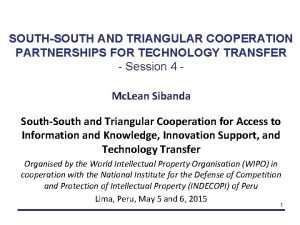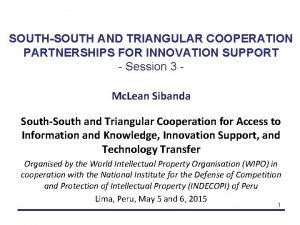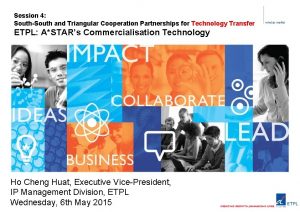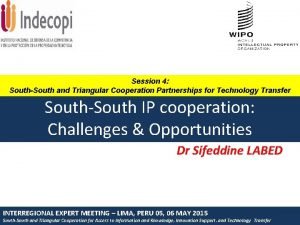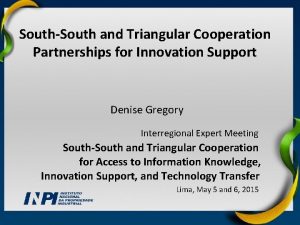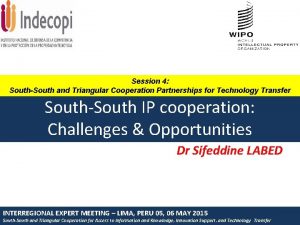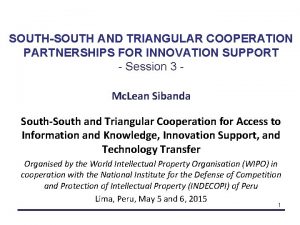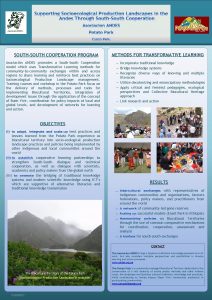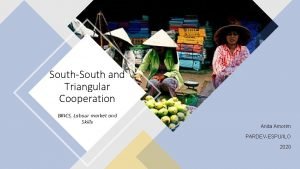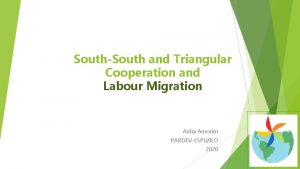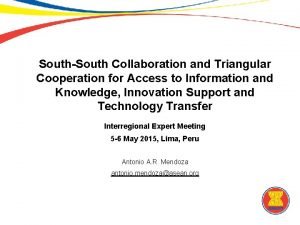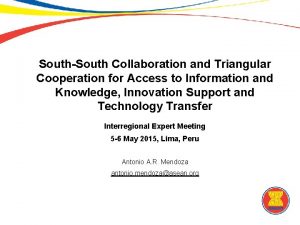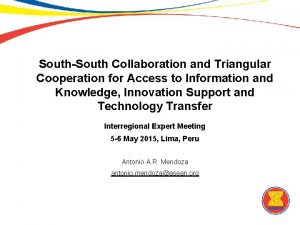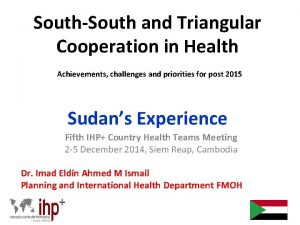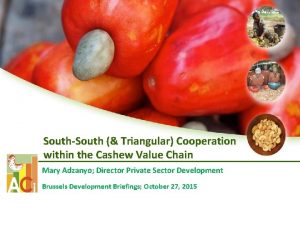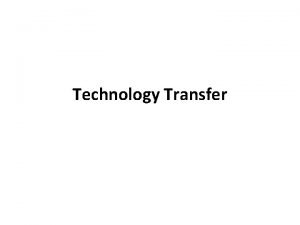SOUTHSOUTH AND TRIANGULAR COOPERATION PARTNERSHIPS FOR TECHNOLOGY TRANSFER


















- Slides: 18

SOUTH-SOUTH AND TRIANGULAR COOPERATION PARTNERSHIPS FOR TECHNOLOGY TRANSFER - Session 4 Mc. Lean Sibanda South-South and Triangular Cooperation for Access to Information and Knowledge, Innovation Support, and Technology Transfer Organised by the World Intellectual Property Organisation (WIPO) in cooperation with the National Institute for the Defense of Competition and Protection of Intellectual Property (INDECOPI) of Peru Lima, Peru, May 5 and 6, 2015 1

Presentation Outline q Introduction q Technology Transfer Partnerships / Initiatives q Specific Partnerships in Africa § § § i. Themba Pharmaceuticals (South Africa) Bio. VAC / Heber Biotec (South Africa) East Coast Rapid Diagnostics (South Africa) African Agricultural Technology Foundation (AATF) (Kenya) Aspen Pharmacare (South Africa) Huajan Shoes (Ethiopia) q Concluding Remarks 2

Introduction Africa’s Attractiveness as an Investment Destination 3

Introduction Investors per sector in FDI Projects in Africa 4

Technology Transfer Partnerships / Initiatives Expanding the National Systems of Innovation Technology Transfer essential for development of local technological base and capabilities and consequently strengthening the economy of the receiving country q Critical mass of STI human capital a prerequisite § § Absorption capacity Adaptation and endogenous innovative capacity q Building a bridge between R&D and the market (increased focus on commercialisation) q Right mix of institutional arrangements q Appropriate funding instruments and incentives q Expand on the local private sector q Entrepreneurship and building local industries 5

Specific Technology Transfer Partnerships Emory University (USA) – i. Themba Pharmaceuticals (South Africa) … 1 Licensed Patents / know-how: • Synthesis method for Abacavir • Novel compounds for treatment of latent TB infections Emory University (USA) Scientific Advisory Board (top class researchers in USA, UK and SA institutions) TIA (SA Government Fund) 6

Specific Technology Transfer Partnerships Emory University (USA) – i. Themba Pharmaceuticals (South Africa) … 2 q Outcomes § § § R&D capacity developed incl. secondments to Emory Abacavir process developed Contract R&D opportunities secured Human factors Access to patent pool pipeline q Challenges § § § Limited funding with constraints Investor changes (LIFELab / Bio. PAD to Technology Innovation Agency) Shareholder challenges owing to change of investors Unaligned vision Unstable leadership q Lessons Learnt § § § Need to secure sufficient funding runway Investor(s) alignment Joint ownership with each party realising importance of relationship Leadership matters Regulatory hurdles must not be overlooked 7

Specific Technology Transfer Partnerships Cuban Heber Biotec – Bio. Vac Institute (South Africa) … 1 Technology transfer partnerships with Sanofi Pasteur and Biofarma in the area of vaccines 8

Specific Technology Transfer Partnerships Cuban Heber Biotec – Bio. Vac Institute (South Africa) … 2 9

Specific Technology Transfer Partnerships Cuban Heber Biotec – Biovac Institute (South Africa) … 3 10

Specific Technology Transfer Partnerships East-Coast Rapid Diagnostics … 1 q Technology transfer from Tulip Group Diagnostics (India) § § § Malaria Pregnancy Urine dip stick technology q Substantial capacity and technical assistance q Facilitated by public biotechology funding agency – LIFElab (Durban South Africa) q Joint Venture (Tulip Diagnostics, LIFELab and LIFEAssay) q South Africa and other African markets 11

Specific Technology Transfer Partnerships East-Coast Rapid Diagnostics … 2 q Challenges § Lack of capacity to transfer § Absorption capacity § Human factors § § § q Lessons Learnt § Clear win-win must be established from the on-set § Sufficient funding run-way essential Funding § Local partner, LIFEAssay already had a product(s) ready to go to market competitive advantage Commitment to effecting technology transfer as expediently as possible § Relationships matter § Absence of intellectual property rights makes it more challenging – maintaining competitive advantage LIFELab merger with other entities to establish Technology Innovation Agency 12

Specific Technology Transfer Partnerships African Agricultural Technology Foundation … 1 q Established in 2003 q Focus on Public-Private-Partnerships § § transfer, development, production and distribution of technology to smallholder farmers in Sub-Saharan Africa Based in Nairobi (Kenya) q Addressing food security and climate change q > 30 technologies accessed (US$180 m) q Majority accessed have since been developed and adapted in Africa q Manages > 20 technology licenses 13

Specific Technology Transfer Partnerships African Agricultural Technology Foundation: Wema Project … 2 q AATF, CIMMYT, Monsanto and National Agricultural Research Systems of Kenya, Mozambique, South Africa, Tanzania, Uganda q Research collaboration to develop and deliver Water Efficient Maize for Africa (“WEMA”) q Elite maize germplasm, advanced breeding methods and biotechnology, national field trials to select the best seed for deployment q Licensed seed companies will not pay a royalty for any intellectual property (“IP”) in maize seed sold to small holder farmers § § § Each party owns background technology, germplasm and IP contributed to the Project; free to use such outside of the Project Each party will also own (solely or jointly) the IP that it develops in carrying out the WEMA Project Germplasm will be owned by the party whose breeding program developed such germplasm 14

Specific Technology Transfer Partnerships Pharmaceutical Sector: Aspen Pharma (South Africa) Multinational patent holders (incl. GSK, Boehringer Ingelheim US$3 b Voluntary licences • Technology transfer • Low cost producer • US 28. 5 m pharmaceutical manufacture facility • Strategic Investment Programme (SIP) • Access to market the dti (SA Government) 15

Specific Technology Transfer Partnerships Chinese Shoemaker Huajian Manufactures in Ethiopia (Jan 2012) § Ethiopian climatic conditions and cheaper labour § Opened factory in January 2012 (Addis Ababa) and now employ >600 people § By 2022 will have created > 100, 000 jobs § Local employment and skills transfer / upgrade 16

Concluding Remarks q Barriers in technology transfer partnerships: § § Poor understanding of the IP system Low supply of high-end skills beyond commodity orientation Inadequate R&D investment and follow on funding - patient capital Private sector not involved early enough or simply missing q Some critical lessons: § § § Securing appropriate funding runway / patient capital Continuous alignment of vision and purpose Trust issues: People do business with people Development oriented IP approach and clauses Relevant institutions and institutional frameworks q Government incentives, including procurement as a lever for transfer of technology, capacity building, market access 17

Thank You 18
 Examples of diagonal matrix
Examples of diagonal matrix Accounting for partnerships chapter 12 solutions
Accounting for partnerships chapter 12 solutions Accenture barclays project
Accenture barclays project Word partnerships examples
Word partnerships examples Product development partnerships
Product development partnerships What is jit
What is jit Maintaining effective partnerships
Maintaining effective partnerships Public partnerships my account registration
Public partnerships my account registration Epsrc prosperity partnerships
Epsrc prosperity partnerships Chapter 12 accounting for partnerships answers
Chapter 12 accounting for partnerships answers Agriculture cooperation and farmers welfare
Agriculture cooperation and farmers welfare National technology transfer and advancement act
National technology transfer and advancement act What is a disturbance that transfers energy
What is a disturbance that transfers energy What does cooperation sound like
What does cooperation sound like Social interaction cooperation
Social interaction cooperation Ilac mra
Ilac mra Ea european accreditation
Ea european accreditation Cooperation relationship ecosystem
Cooperation relationship ecosystem Offer for cooperation
Offer for cooperation
